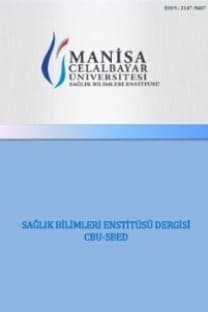Süperior Pediküllü Retroauriküler Flep ile Kulak Sayvanı Defektlerinin Onarımı
Superior Pedicled Retroauricular Flap for Auricle Defect Repair
___
- 1. Leferink VJ, Nocolai JP. Malignant tumors of the external ear. Annals of Plastic Surgery 1988, 21(6),550-4
- 2. Steele J, Farmer E, et al. Ear aesthetics: Investigation by the use of an online viral survey. Annals of Plastic Surgery 2017, 78(3), 330–3
- 3. Adler N, Ad-El D, et al. Reconstruction of nonhelical auricular defects with local flaps. Dermatologic Surgery 2008, 34(4), 501- 7
- 4. Levin BC, Adams LA, et al. Healing by secondary intention of auricular defects after Mohs surgery. Archieves of Otolaryngology Head & Neck Surgery 1996, 122(1),59-66
- 5. Peled IJ. Healing of eardefects: Primary or secondary. Plastic and Reconstructive Surgery 1997, 100(1), 277-9
- 6. Trufant JW, Marzolf S, et al. The utility of full-thickness skin grafts (FTSGS) for auricular reconstruction. Journal of the American Academy of Dermatology 2016, 75(1), 169–76
- 7. Armin BB, Ruder RO, et al. Partial auricular reconstruction. Seminars in Plastic Surgery 2011, 25(4), 249–56
- 8. GómezDíaz OJ, CruzSánchez MD. Anatomical and Clinical Study of the Posterior Auricular Artery Angiosome: InSearch of a Rescue Tool for Ear Reconstruction. Plastic and Reconstrictive Surgery Global Open 2016, 4(12), e1165
- 9. Oh SH, Kyung HW, et al. The vascular system of the superior auricular artery: anatomical study and clinical application. Dermatologic Surgery 2011,37(1), 65-72.
- 10. Yang D, Morris SF. Vascular basis of the retroauricular flap. Annals of Plastic Surgery 1998,40(1),28–33
- 11. Turan A, Turkaslan T, et al. Reconstruction of the anterior surface of the ear using a postauricular pull-through neurovascularis land flap. Annals of Plastic Surgery 2006, 56(6), 609-13
- 12. Dessy LA, Figus A, et al. Reconstruction of anterior auricular conchal defects after malignancy excision: Revolving-door flap versus full-thickness skin graft. Journal of Plastic, Reconstructive & Aesthetic Surgery 2010, 63(5), 746–52.
- 13. Yoshimura K, Ouchi K, et al. Surgical correction of cryptotia with superiorly based superfcial mastoid fascia and skin paddle. Plastic Reconstructive Surgery 2000,105(3), 836–41
- 14. Okuyucu, S, Balcı, DD,et al . Kulak Konkası Defektlerinin Tamirinde Postaurikuler Rotasyon Flebi Kullanımı. KBB-Forum Dergisi 2008, 7(3)
- 15. Oh SH, Kyung HW, et al. The vascular system of the superior auricular artery: Anatomical study and clinical application. Dermatologic Surgery 2011, 37(1), 65-72
- 16. Yotsuyanagi T, Watanabe Y, et al. Retroauricular flap: its clinical application and safety. British Journal of Plastic Surgery 2001,54(1),12–9
- 17. Kaplan AL, Cook JL. The incidences of chondritis and perichondritis associated with the surgical manipulation of auricular cartilage. Dermatologic Surgery 2004, 30(1), 58-62
- ISSN: 2147-9607
- Yayın Aralığı: 4
- Başlangıç: 2014
- Yayıncı: Manisa Celal Bayar Üniversitesi Sağlık Bilimleri Enstitüsü
Manisa’da 5-14 Yaş Arası Çocuklarda Enürezis Nokturna Sıklığı ve İlişkili Faktörler
Berna BİLGİN ŞAHİN, Pınar ERBAY DÜNDAR
SÜPERİOR PEDİKÜLLÜ RETROAURİKÜLER FLEP İLE KULAK SAYVANI DEFEKTLERİNİN ONARIMI
Yavuz KEÇECİ, Zülfükar Ulaş BALİ
Koray ERBÜYÜN, Eralp ÇEVİKKALP, Demet AYDIN TOK, Gülay OK, İdil TEKİN
Şizofreni hastalarının bakım verenlerinde duygu dışa vurum ve mizaç özellikleri ilişkisi
Çağdaş Öykü MEMİŞ, Bilge DOĞAN, Müge BULUT, Yaşan Bilge ŞAİR, Levent SEVİNÇOK
Gebelikte Prenatal Bağlanma ve Vücut Algısı Arasındaki İlişki ve Etkileyen Faktörler
Tuba ÖZKAN, Didem ŞİMŞEK KÜÇÜKKELEPÇE, Semiha AYDIN ÖZKAN
Yüksek Riskli Gebelerde Anksiyete ve Depresyon ile Hemşirelik Bakım Memnuniyetinin İncelenmesi
Duygu GÜLEÇ, Ayse EMİNOV, Oya KAVLAK
MANİSA’DA 5-14 YAŞ ARASI ÇOCUKLARDA ENÜREZİS NOKTURNA SIKLIĞI VE İLİŞKİLİ FAKTÖRLER
Berna BİLGİN ŞAHİN, Pınar ERBAY DÜNDAR
Gebelikte Tromboemboli ve Antikoagülan Kullanımında Ebelik Yaklaşımı
Ünzüle SERİN, Nuran AYDIN ATEŞ, Asiye AYAR KOCATÜRK
Eralp ÇEVİKKALP, Gülay OK, Koray ERBÜYÜN, Demet AYDIN, İdil TEKİN
